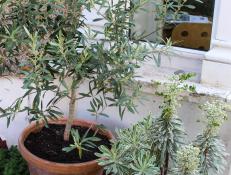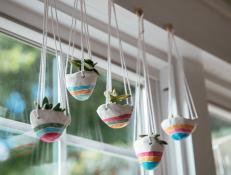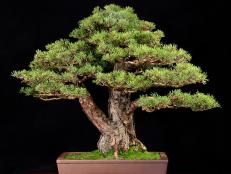Frangipani

Plant type: Deciduous to evergreen shrubs or small trees
Hardiness: USDA Zones 10 to 11
The waxy, richly fragrant flowers of frangipani are a joy to behold. These tropical treasures produce thick, fleshy stems with long, narrow, leathery leaves only at the ends of the stems. Most frangipani plants drop their leaves in the winter, but a few are evergreen. In spring, clusters of blooms appear at the very tips of the shoots. The large individual flowers are tubular at the base, flaring out to five flattened petals arranged in a pinwheel pattern. They may be yellow, red, pink or white, sometimes with multiple colors in each blossom. New flushes of bloom may appear during the summer and last into fall. Where it is winter-hardy, frangipani can eventually reach 20 to 40 feet tall when grown in the ground. In a pot, it's typically just a few feet tall.
How to use it: In frost-free areas, grow frangipani as a single specimen or in small groupings in the landscape. Elsewhere, keep it in a container and enjoy its summer color and fragrance on your deck or patio, then bring it inside for the winter.
Culture: The plants can tolerate partial shade, but they grow and bloom best with full sun. Water regularly (allowing the soil to dry out a bit between waterings) from spring to fall, and fertilize regularly in spring and summer. In fall, start watering more sparingly and stop fertilizing altogether. Bring potted plants indoors as soon as nighttime temperatures start to reach around 50 degrees F and give them a sunny, frost-free spot. Let the soil go almost completely dry in the winter. Keep in mind that frangipani shoots branch only after flowering, so don’t be tempted to pinch off the shoot tips to encourage bushier growth. Propagate from cuttings in early spring. Be patient with young, single-stemmed plants; they may take two or three years to reach flowering size.
Special notes: Frangipani's long-lasting flowers and incredible fragrance make it a treat to grow in any garden. Just be sure to keep it where it won't get jostled or knocked over: The stems are thick but rather brittle, and they contain a milky sap that can irritate skin and eyes or cause an upset stomach if ingested.
Selected species
- White frangipani (Plumeria alba). Typically has yellow-centered white flowers; deciduous.
- Singapore frangipani (P. obtusa). This too has white flowers with yellow centers, but its leaves are shorter than those of P. alba, and it tends to be evergreen.
- Frangipani (P. rubra). Usually flowers in shades of red to pink, but its cultivars and hybrids come in a range of colors; deciduous.













































